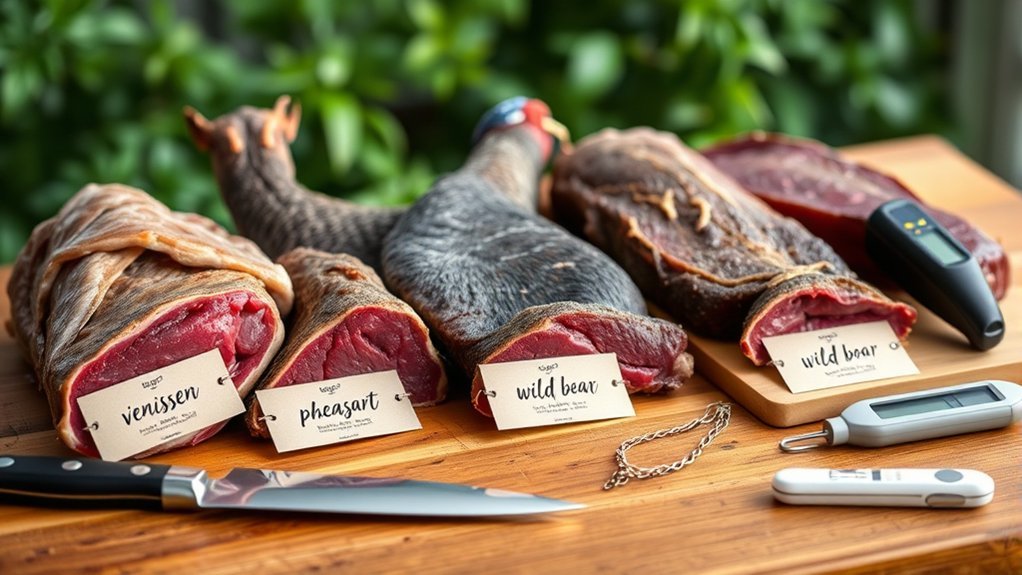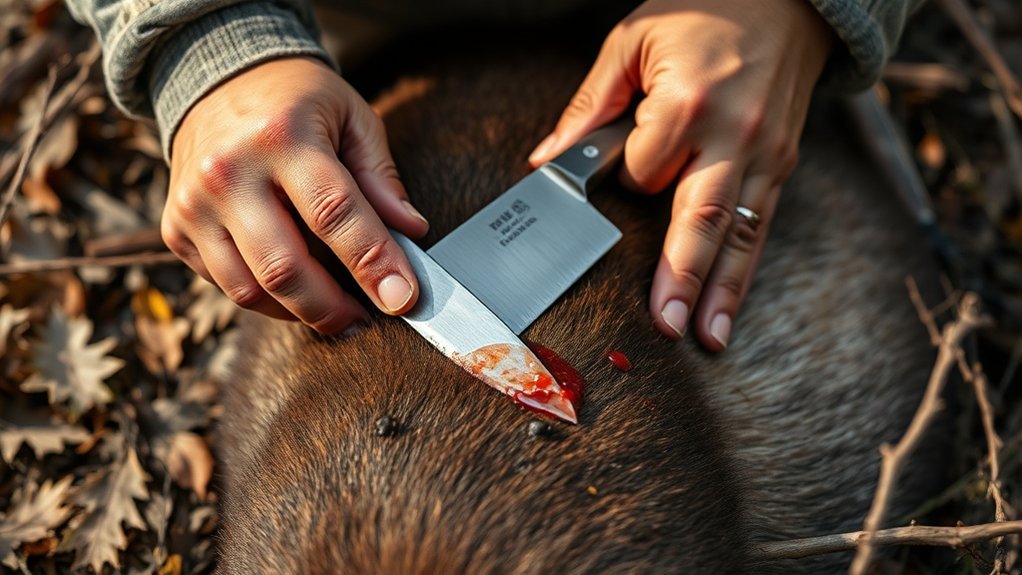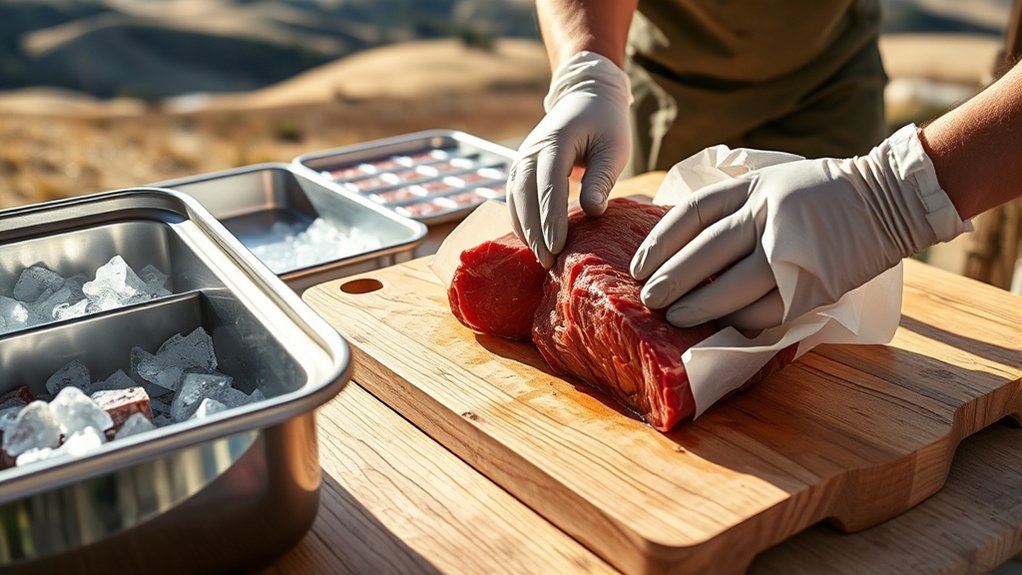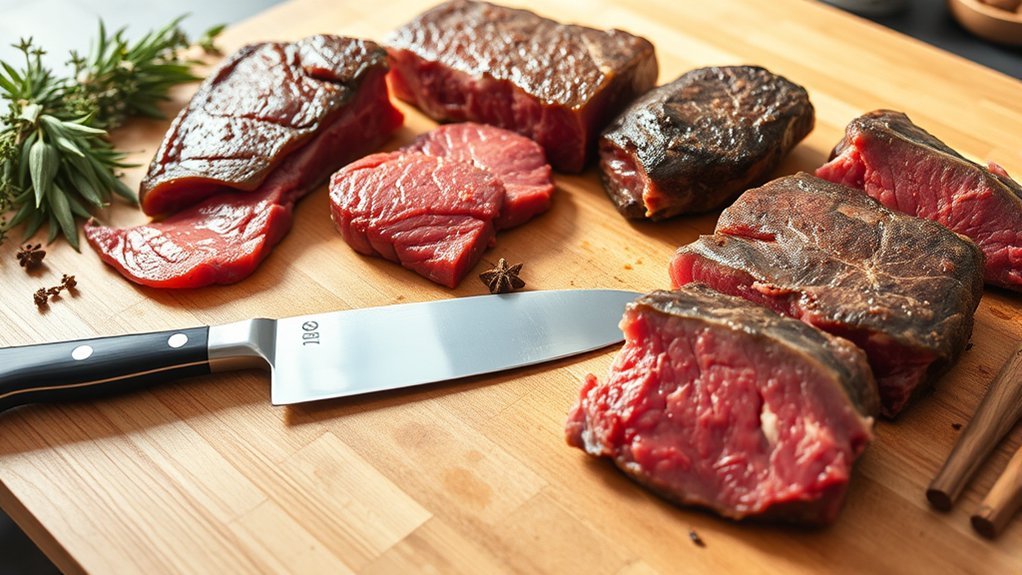When it comes to game meat care and food safety, understanding the nuances is essential. You need to take into account various factors, from field dressing techniques to proper storage methods. Each step plays an important role in preventing contamination and spoilage. Are you aware of the best practices for handling and cooking game meat? Exploring these essentials can greatly impact the quality and safety of your next harvest.
Understanding Game Meat Types

When it comes to game meat, understanding the different types is essential for both hunters and consumers. Game meat generally falls into two categories: big game and small game. Big game includes larger animals like deer, elk, and moose, known for their rich flavors and higher fat content. These meats often require careful consideration of cooking methods to enhance tenderness and taste. Small game, such as rabbits and squirrels, tends to be leaner and can benefit from quicker cooking techniques to prevent dryness. Additionally, birds like pheasants and ducks offer unique textures and flavors, requiring distinct preparations. Recognizing these variations helps you make informed choices, ensuring that you appreciate the culinary potential of each type of game meat.
Essential Field Dressing Techniques

When field dressing game, selecting the right tools is essential for efficiency and safety. You should follow a step-by-step process to guarantee proper handling and minimize contamination. Keeping hygiene practices at the forefront will help maintain the quality of the meat you harvest.
Proper Tools Selection
Choosing the right tools for field dressing game meat is essential for guaranteeing both safety and efficiency. Having the proper equipment not only speeds up the process but also minimizes the risk of contamination. Here are key tools you should consider:
- Sharp Knife: A sturdy, sharp knife is critical for clean cuts.
- Field Dressing Gloves: Disposable gloves help prevent cross-contamination.
- Game Bags: These keep the meat clean and protected from insects.
- Bone Saw: Useful for larger game, guaranteeing quick access to important organs.
- Thermometer: Checks meat temperature to guarantee safety and quality.
Investing in these tools prepares you for a successful field dressing experience, allowing you to focus on the task at hand without unnecessary delays or hazards.
Step-by-Step Process
Equipped with the right tools, you’re ready to begin the field dressing process, which is essential for preserving the quality of the meat. Start by laying the animal on its back, ensuring it’s stable. Make a shallow incision at the base of the belly, careful not to cut too deep. From there, extend the incision toward the sternum, avoiding any organs. Use your hands to gently pull apart the skin and flesh as you work. Once you’ve reached the pelvic area, carefully cut around the pelvis to free the intestines. After removing the internal organs, inspect for any signs of contamination. Finally, hang the carcass in a cool, shaded area to allow it to cool down quickly, maintaining ideal meat quality.
Hygiene and Safety Practices
Maintaining strict hygiene and safety practices during field dressing is essential for guaranteeing that the meat remains safe to consume. To minimize contamination risks, follow these critical techniques:
- Wear gloves: Protect your hands from bacteria and pathogens.
- Use clean tools: Confirm knives and equipment are sanitized before use.
- Work in a cool environment: Keep the carcass at a safe temperature to prevent spoilage.
- Avoid cross-contamination: Keep raw meat separate from other food items.
- Check for signs of spoilage: Inspect the meat for any unusual odors or discoloration.
Implementing these practices will considerably reduce the risk of foodborne illness and contribute to the overall quality of your game meat. Stay vigilant and prioritize safety throughout the process.
Proper Handling and Transportation

When handling game meat, using clean equipment is vital to prevent contamination. Additionally, maintaining proper temperature during transportation is imperative to guarantee the meat stays safe for consumption. By prioritizing these factors, you can greatly reduce the risk of foodborne illnesses.
Clean Equipment Usage
Proper handling and transportation of game meat hinge on using clean equipment. Maintaining cleanliness is vital to prevent contamination and guarantee your meat stays safe for consumption. Here are some essential tips for clean equipment usage:
- Use dedicated tools: Designate specific knives, cutting boards, and containers for game meat.
- Sanitize regularly: Clean equipment with hot soapy water and disinfectants before and after use.
- Inspect for damage: Check for cracks or crevices on equipment that can harbor bacteria.
- Transport in sanitized containers: Use clean, food-safe containers for transporting game meat.
- Avoid cross-contamination: Keep raw game meat separate from cooked foods and other items.
Temperature Control Importance
Temperature control plays a critical role in guaranteeing the safety and quality of game meat during handling and transportation. When you harvest game, it’s essential to cool the meat quickly to prevent bacterial growth. Ideally, meat should be chilled to below 40°F (4°C) within a few hours. Use ice or refrigeration during transport to maintain this temperature.
Avoid leaving meat in warm environments, as this can compromise its safety and flavor. Additionally, if you’re transporting larger quantities, consider using insulated coolers or refrigerated vehicles. Regularly monitor the temperature with thermometers to guarantee compliance. By prioritizing these temperature control measures, you not only protect your health but also preserve the quality of the game meat for consumption.
Effective Cooling and Storage Methods
Although game meat is highly prized for its unique flavors and nutritional benefits, guaranteeing its safety through effective cooling and storage methods is essential. To maintain quality and prevent spoilage, follow these practices:
- Cool immediately: Rapidly cool the meat to 40°F (4°C) or below.
- Use ice packs: If you can’t access a fridge, use ice packs in a cooler to keep temperatures low.
- Store in airtight containers: This prevents contamination and preserves freshness.
- Label and date: Always mark storage bags or containers with the date to track freshness.
- Monitor temperatures: Use a thermometer to guarantee your storage environment stays within safe temperature ranges.
Safe Processing and Butchering Practices
Maintaining the integrity of game meat extends beyond cooling and storage; it also encompasses safe processing and butchering practices. Start by using clean, sanitized tools to minimize contamination. Always wear gloves to protect both yourself and the meat from pathogens. Make certain your workspace is free from dirt and debris, and keep all surfaces sanitized. When butchering, make precise cuts to avoid bruising the meat, and be mindful of where you place your hands to prevent cross-contamination. Store processed meat in airtight containers to preserve quality and prevent spoilage. Finally, label your packages with the date to track freshness. By following these practices, you’ll make certain the meat remains safe and delicious, ready for your culinary endeavors.
Cooking Techniques for Game Meat
Cooking game meat requires specific techniques to enhance its unique flavors and guarantee ideal tenderness. Unlike domestic meats, game meat is often leaner and can become tough if not cooked properly. To achieve the best results, consider the following techniques:
- Marinating: Use acidic ingredients to tenderize and infuse flavor.
- Slow Cooking: Employ low temperatures for extended periods to break down tough fibers.
- Grilling: Quickly sear over high heat to lock in moisture while maintaining juiciness.
- Sous Vide: Cook in a temperature-controlled water bath for precise doneness and tenderness.
- Resting: Allow the meat to rest post-cooking to redistribute juices.
Recognizing Signs of Spoilage
After you’ve mastered the cooking techniques for game meat, it’s essential to guarantee that the meat you’re working with is safe to consume. Recognizing signs of spoilage is vital. First, examine the color; fresh game meat should be vibrant and consistent. If you notice dullness or unusual discoloration, it may be spoiled. Next, check for an off or sour odor, which is a strong indicator of spoilage. Additionally, feel the texture; fresh meat should be firm and moist, while sliminess suggests bacterial growth. Finally, inspect for any unusual or excessive liquid pooling, which can signal deterioration. Trust your senses—if something seems off, it’s best to err on the side of caution and discard the meat. Your health depends on it.
Conclusion
In summary, understanding game meat care and food safety is essential for your health and enjoyment. Did you know that nearly 60% of foodborne illnesses stem from improper handling and storage? By mastering proper field dressing, handling, and cooking techniques, you can greatly reduce the risk of contamination. Stay vigilant about spoilage signs to guarantee your meals are safe and delicious. Prioritizing these practices not only protects you but also enhances your overall game meat experience.

